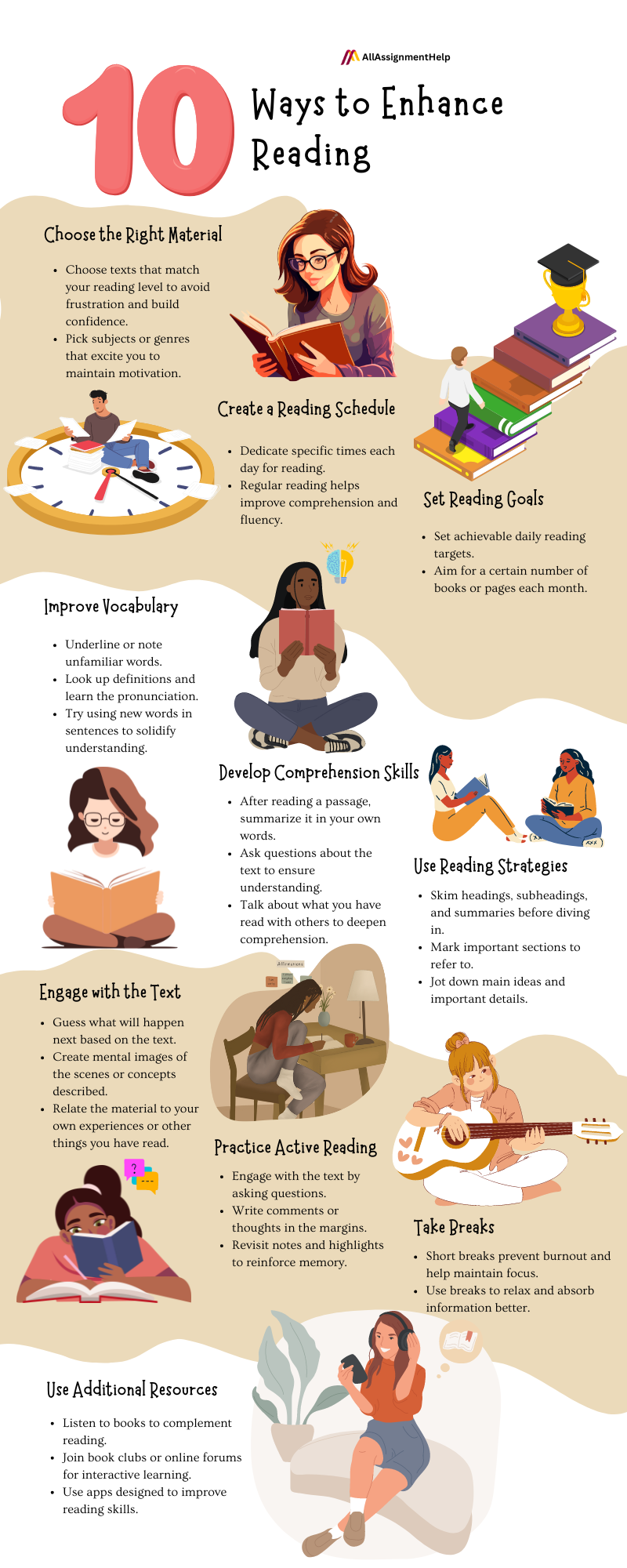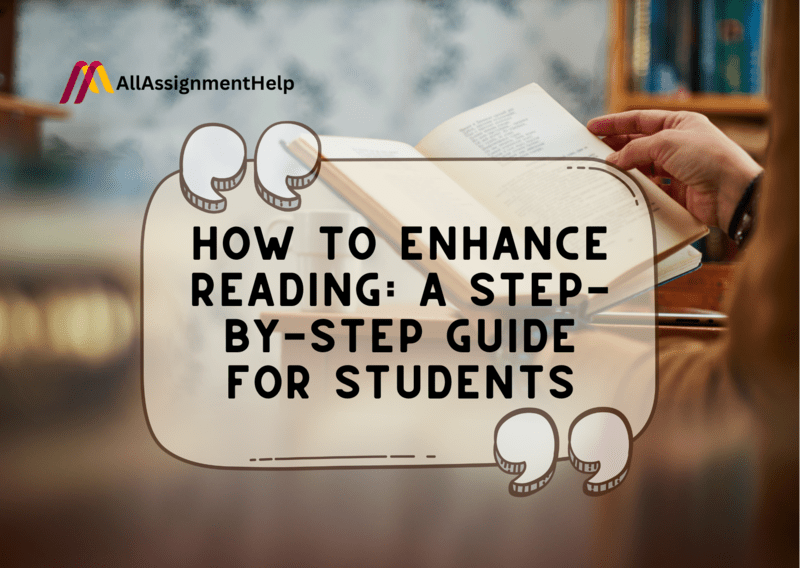Table of Contents
A student’s intellectual and personal development can be greatly enhanced by reading. Beyond the classroom, it supports critical thinking, expands vocabulary, and fosters empathy. Establishing a reading habit gives students the tools they need for both academic performance and personal development in this time of computers and constant interruptions.
Moreover, through understanding the opinions, cultures, and ideas found in the literature, the students broaden their understanding of the world. Furthermore, with the help of this blog by All Assignment Help, we will study some of the proven steps that help in making one’s reading better.
Additionally, if you implement these steps into your reading habits, it will foster creativity by promoting imagination and inventiveness. Also, it will improve the intellect and soul. Hence one can read classic literature, contemporary fiction, or science publications.
Step 1: Set Clear Reading Goals
Getting to form a reading habit can be a challenging endeavour, isn’t it? Hence, setting reading goals is one way to make it simple. Students who set realistic and attainable reading objectives will be able to take charge of their education and maintain their motivation to read more.
Moreover, when establishing a goal, be careful to specify precisely what you want to know at the end of the allotted period. Furthermore, when defining a reading goal, you should concentrate on phonemic awareness, phonics, fluency, vocabulary, and reading comprehension. Additionally, this is where you should begin if you find yourself wondering what reading goals are.
Reading goals means setting a realistic objective that can be attained in a set period. For example, the reading goal of a student can sound like, I wish to be able to read scientific essays effortlessly in 6 months. To attain such goals, students can try the SMART goals. It means being measurable, realistic, achievable, relevant, and time-bound. SMART is an abbreviation for:
- Specific
- Measurable
- Achievable/Attainable
- Relevant/Realistic
- Time-bound
Not being able to read effectively can affect your academic assignments as well. Poor reading means poor comprehension of context and inability to compose ideas effectively. However, whilst you are working on your reading abilities, you can seek online assignment help to get your academic tasks done on time.
Tips for setting SMART goals
- Your objectives should be ones that inspire you. The possibility that you will succeed in reaching your objectives is significantly increased if you have a strong desire to do so.
- Begin by deciding on a broad objective that you want to pursue and then segment that objective into more manageable, highly specific goals that you can complete faster.
- It is crucial to consider your personal motivations for each goal you set when making them.
- Your goals should be specific in terms of dates, quantities, and other details so that you can track your progress towards them.
- Setting objectives that are in line with your personal life goals or desired job path is crucial.
- It is critical to create controllable goals if you want to accomplish them. Setting goals that depend on other people makes you dependent on them to fulfil their end of the bargain.
- Making an action plan is especially crucial if the objective you are working towards is difficult or long-term.
Furthermore, it is critical that you pay attention to the steps involved in reaching your SMART goals as well as the advancements you are making.
Also read: A Comprehensive Guide to Mastering the Art of Reading a Textbook?
Step 2: Create a Comfortable Reading Environment
The environment has a great influence on how people behave. Numerous factors, like temperature, light, noise, and space, have an impact on us. Our attitude, energy, motivation, efficiency, and sense of security can all be affected by any of these things and more.
Reading time is no different. Thus, how can we design a reading area that is ideal for us as students? Here are a few quick and practical ideas:
- Smartphones are a constant source of distraction and entertainment. Put all gadgets in a basket out of reach and sight, and remember to set them to “Do Not Disturb.”
- A neat and well-organized reading space is the ideal one.
- Make sure you can spend a lot of time in your reading area without feeling too uncomfortable.
- Physical comfort is greatly influenced by temperature, ventilation, and lighting. Let some fresh air and natural light in by opening a window.
- People who spend time reading may feel more exposed. Hence, your readers’ sense of security and comfort can be increased by privacy.
Also read: How Newspaper Reading Can Be Beneficial to Students
Step 3: Develop a Reading Schedule
Regular practice improves fluency, vocabulary, and understanding whether reading is done alone or as part of a planned school activity. Moreover, students gain comfort and familiarity with written language when they make reading a daily practice.
How to integrate reading into your daily routine
- Because of the chaos in our lives, it might be difficult to find time to read. However, if you set aside 15 minutes each day to read, you will begin your day with ideas that will broaden your horizons and end your night with thoughts other than work-related ones.
- Think about switching to audio instead of reading. Podcasts and audiobooks are two examples of very effective information consumption methods.
- You will never read if it is not a priority for you. Thus, begin by declining one assignment per week and use that time to read instead of doing the task. Suppose, you have given up on your academic assignment to give some time to reading then do it in peace. Now, you do not need to worry about how I can do my assignment now. Having such thoughts would not let to focus on either reading or writing your assignment. Therefore, seek expert guidance.
- Instead of trying to schedule reading time, just give yourself permission to read whatever information you come across on any platform.
Tips for balancing reading with other academic responsibilities
It can be difficult, but it is possible to balance reading and academics. The following advice can assist you in finding a balance that suits you:
- Allowing adequate time to study and finish your projects every day. Seek assistance from a teacher or tutor if you are having difficulty in a class.
- Limiting your commitments is essential.
- Maintain a record of your reading, homework, and other responsibilities by using a planner or calendar.
- Make sure you eat well, exercise frequently, and get adequate sleep. This will sustain your well-being and concentration.

Step 4: Practice Active Reading Techniques
Reading is not enough; it is a passive behaviour. Hence, it is necessary for you to be engaged. As you read, you should be asking yourself questions, thinking, writing, summarizing, reflecting, and speaking aloud. For active reading, try considering the following.
- Connect what you read to what you already know from the course material or from a prior course.
- Examine the reading aloud for connections and trends.
- Use pictures and visualizations to make the material easy to recall.
- Interpret the text by putting it in your own terms.
- Enquire about stuff you have not read yet.
- Find out the definitions of words and terminology you are unsure about.
- Keep an eye on your understanding of the information.
- Compare and contrast the text with the notes from class.
- Provide your own instances of notions.
- Consider the significance of the information and how it connects to other ideas.
Also read: How to Focus on Reading? Let Us Learn
Step 5: Enhance Vocabulary
The English language relies heavily on its vocabulary. Your ability to understand what you read will improve as your vocabulary grows. Since words are everywhere, comprehension increases as we increase our vocabulary and word knowledge. Moreover, vocabulary is the first area in our memory system to access information because it is the foundation of words and their meanings. To interpret words, our brain searches through our memory bank.
Furthermore, much research demonstrates how vocabulary knowledge helps in the reading comprehension process by improving word semantic meaning recall, speed, and quality to help readers form mental images of the text they were reading.
Tips for learning new words
- Form a reading routine.
- Turn to your thesaurus and dictionary.
- Play word puzzles.
- Use flashcards.
- Get “word of the day” feed subscriptions.
- Use mnemonic devices.
- Try conversing with new words you have learnt.
In addition to this, you can enrol yourself to an online English language course. Here, they will help you in learning the language through and through and make your reading ability better. However, on days when some unforeseen circumstances prevent you from taking your class, thoughts like, who can help me take my online English class now, might pop up in your head. Well! You do not have to worry as we will never let anything come in your way of learning to read profoundly. Experts on our website can guide you in taking classes on such troublesome days.
Step 6: Improve Reading Speed
The volume of material that you must read as a college student may cause you to feel overburdened. You need to improve your reading speed as a result. Moreover, it is preferable to begin with an article from a newspaper or magazine when you are initially learning how to boost your reading speed. Instead of reading individual words, practice reading groups of words at a time. To help you read more quickly, get a “pacer.” Pacers are intended to assist you in focus when reading and to accelerate the movement of your eyes.
Measuring and improving reading speed
Between 250 and 350 words per minute is a decent target to aim for. In comparison, the typical college student reads between two and three hundred words per minute. Select an item to read for thirty seconds to determine your reading pace. After you have stopped reading, count how many words you have read, and then double that number. The outcome is your word-per-minute reading rate. Also, seek guidance from our online essay helper in case you need assistance to write a top-notch English essay.
Step 7: Reflect on What You Have Read
To understand the reading for a longer period, you must review what you have read. A powerful method can help you with this. The SQ3R technique, introduced by Francis Pleasant Robinson, is a proven method that will help students learn effectively. Now you must be thinking about what SQ3R stands for. S- stands for Survey, and Q means Question and the 3 R stands for Read, Recite, and Review. Make sure you include this specific technique while reading.
Conclusion
Reading fluency gives students the freedom to examine difficult texts on their own and to write with confidence. Success in both the workforce and higher education requires these essential abilities.
Frequently Asked Questions
| Question: What are the various pre-reading techniques used during the reading process? Answer: The different prereading strategies involved in the reading are scanning the writing, skimming the text, making relationships, and giving predictions on the decoded knowledge. |
| Question: What is silent reading? Answer: It is a reading process in which the reader prefers to read silently. This is one of the great qualities of a good reader, as in this you not only read the words but make a connection with the words. |
